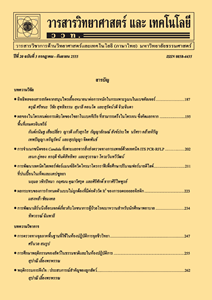Life Cycle Greenhouse Gases Emissions of Processed Frozen Chicken
Main Article Content
Abstract
The objective of this study is to evaluate greenhouse gas emissions in the life cycle of frozen processed chicken meat in order to identify the important activities (hotspots) which contribute to the greenhouse gases emissions. The scope of the study is based on the cradle-to-gate approach, which included (1) feed production, (2) pullet farm, (3) hatchery farm, (4) broiler chicken farm, (5) slaughterhouse, and (6) frozen processing factory. The functional unit is 1 kg of frozen processing chicken meat. The research methodology is based on ISO 14040 and the guideline of Thailand Greenhouse Gas Management Organization (TGO). Greenhouse gas emissions are calculated in the unit of kgCO2-eq. The result of the greenhouse gas emissions of 1 kg of frozen processing chicken meat is 2.51 kg CO2-eq. The results indicated that feed production and acquisition (in particular, the acquisition of soybean meal and maize), broiler chicken farm, and frozen processing factory mainly contributed to the emissions by about 50, 26, and 21 %, respectively. Various potential options for greenhouse gas mitigation are available, for instance, the substitution of raw materials in feed production, changes in the composition of feeds, use of biodiesel in land preparation, effective use of fertilizer, chicken manure management, and increasing yield of feed raw materials.
Article Details
References
Cheewapunyaroj, R. and Sutameung K., 2011, Influence on trust of Bangkokian on frozen food: case study on consumers in Bangkok, J. Fin. Bank Invest. 1: 128-145. (in Thai)
Petchseechuang, W., 2016, Frozen and Processed Chicken Industry and Business Trend in 2016-2018, Available source: https://www.krungsri.com/bank/getmedia/b183a13a-002b-4aa3-8318-ae74566d89b 6/IO_Chicken_2016_TH.aspx, July 8, 2018. (in Thai)
Tongpool, R., Phanichavalit, N., Yuvaniyama, C. and Mungcharoen, T., 2012, Improvement of the environmental performance of broiler feeds: A study via life cycle assessment, J. Clean. Prod. 35: 16-24.
Pelletier, N., 2018, Changes in the life cycle environmental footprint of egg production in Canada from 1962 to 2012, J. Clean. Prod. 176: 1144-1153.
Pelletier, N., Barburu, M. and Xin, H., 2013, A carbon footprint analysis of egg production and processing supply chains in the Midwestern United States, J. Clean. Prod. 54: 108-11.
Pelletier, N., 2017, Life cycle assessment of Canadian egg products, with differentiation by hen housing system type, J. Clean. Prod. 152: 167-180.
González-García, S., Gomez-Fernández, Z., Dias, A., Feijoo, G., Moreira, M.T. and M., Arroja, L., 2014, Life cycle assessment of broiler chicken production: A Portuguese case study, J. Clean. Prod. 74: 125-134.
Suffian, S.A.,Sidek, A.A., Matsuto, T., Muataz, A.L., Yusof, H. and Abdullah, Z.H., 2018, Greenhouse gas emission of broiler chicken production in Malaysia using life cycle assessment guidelines: A case study, Int. J. Eng. Mat. Manu. 3, 87-97.
Raucci, G.S., Moreira, C.S., Alves, P.A., Mello, FF.C., Almeida Frazão, L. and de Cerri, C., 2015, Greenhouse gas assessment of Brazilian soybean production: A case study of MatoGrosso State, J. Clean. Prod. 96: 418-425.
Patthanaissaranukool, W. and Polprasert, C., 2016, Reducing carbon emissions from soybean cultivation to oil production in Thailand, J. Clean. Prod. 131: 170-178.
Cesari, V., Zucali, M., Sandrucci, A., Tamburini, A., Bava, L. and Toschi, I., 2017, Environmental impact assessment of an Italian vertically integrated broiler system through a life cycle approach, J. Clean. Prod. 143: 904-911.
Tangtaweevipat, S. and Cheewaissarakul B., 1992, Seasame meal as soybean meal substitute in broiler diets, J. Agric. 11: 27-38. (in Thai)
Baumgartner, D., de Baan, L., Nemecek, T., Pressenda, F. and Crépon, K., 2008, Life cycle assessment of feeding livestock with European grain legumes, pp. 352-359, Proceedings of the 6th International Conferences on LCA in the Agri-Food Sector, Zurich.


